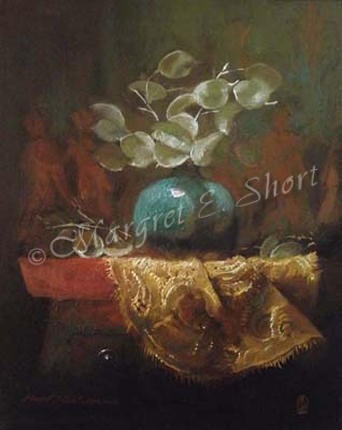
Gifts from the Nubians
©Margret E. Short, 2011, OPA. AWA, 10×8 Oil on Panel
Lessons from the Pharaoh's Tomb, Part Two
Nubia, located just south of Egypt on the Nile River, is known as the Kingdom of Kush and the Land of Gold. Because Egypt had no gold, they were dependent upon the Nubians for this precious metal. Most people lived in farming villages and thought of themselves as Egyptians adopting their style of clothes, jewelry, homes, and daily customs. For many centuries, the two countries lived along the banks of the Nile.
Early one morning while in Egypt, our River Boat Anuket, hosted a group of Nubian craftspeople who sold jewelry and other handcrafted items from their village. I spied a regal looking Nubian with silver hair, and we launched into a long conversation about life in modern Nubia. He was 42, easily looked 72, and had twelve children, many of whom had died. Near the end of our discourse, he asked for my hand in marriage and invited me back to his village. I was honored until I learned he had four other wives waiting at home. When I declined, he seemed disappointed to learn I already was married too, though to just one husband.
The scarf in Gifts from the Nubians depicts the gold the Egyptians traded with their neighbor, and metaphorically represents golden threads woven throughout not only the fabric but also history. For this, I used my substitute for the poisonous orpiment, chrome yellow, yellow ochre, madder, and various earths. The suggestion of table edge is painted with red iron oxide/madder mixture. These two pigments are easily the ones without which I could not have done this project. The jar, again, is painted with the azurite/Egyptian Blue frit combination, and warm earth tones float atop the shadow areas. The silver dollars suggest the importance of trade objects in ancient Egypt, as there was no real money used at that time.
Galerie Gabrie, Pasadena
